Mangrove Cay and the Island’s Wildlife
Discover Breathtaking Nature in Turks and Caicos
Mangrove Cay is a small 286-acre uninhabited island located outside of the leeward development areas – just off the northeastern end of Providenciales. Mangrove Cay is part of the Princess Alexandra Nature Reserve and is almost entirely made up of red mangroves (Rhizophora mangle).
A Kayaking and Paddleboarding Paradise
Mangrove Cay is one of the most popular kayaking and stand-up paddleboarding locations in the Turks and Caicos. Shallow and scenic tidal channels enter the cay in several places and wind their way for thousands of feet. The channels are abundant with wildlife. During high tide, you will likely see many turtles, baby lemon sharks, southern brown stingrays, starfish, and large species of smaller fish, including pufferfish, pelicans, egrets, conch, and much more.
Iguana Island
The larger mangrove trees’ sheltering and complex root systems often hide schools of tiny fish. The Mangrove Cay area is an excellent location for paddlers of all experience levels due to its shallow waters and protection from the wind and waves. There is even a small sandy area where you can occasionally spot a few Turks and Caicos Islands rock iguanas (Cyclura carinata).
A Kiteboarding Paradise
Long Bay Beach boasts one of the longest and best wind conditions you can find anywhere, here is why:
We have a 10 month wind season – Averaging over 90% kiteable days from November to August.
The winds are smooth and stable because they are unobstructed from the ocean. The gusts are minimal which aids in your progression.
The Onshore to Side Onshore wind direction on Long Bay Beach is ideal as you never have to worry about getting blown out to sea! In addition to that, thanks to the massive Caicos Banks, at low tide you can easily walk for a mile in waist deep water, making it ideal for your safety.
When is the best Time to Visit Turks and Caicos Islands?
The Weather Patterns
With the year-round pleasant weather in the Turks and Caicos Islands, there really is no bad time to visit. Though there is some slight variability by season, the normal weather is warm and calm year-round.
Air and Water Temperatures in the Turks and Caicos Islands
The Turks and Caicos Islands enjoy an average of 350 days of sunny skies. Throughout the year, air temperatures range from 75 degrees Fahrenheit to 95 degrees Fahrenheit with only about a 7-degree difference in high temperatures from the hottest summer day to the coolest winter day. However, the summer months are windier, which makes it very comfortable even on the hottest day!
The water temperature is a lovely 74 to 78 degrees during the winter and 82 to 84 degrees in the summer. The turquoise waters have visibility between 80 and 130 feet, making the area an extraordinary paddleboarding and kayaking playground! Check our www.SUPProvo.com for their amazing Turtle eco tours on kayaks and paddleboards. You will see all the incredible underwater wildlife from the view of your paddleboard.
Seasonal Weather Patterns in the Turks and Caicos Islands
Besides the temperature, the other aspects of seasonal variability in the Turks and Caicos Islands are subtle. The strongest winds are in the Summer months from May – August! Many of our guests come in the Winter to escape colder weather in the North, but we encourage you to come in the summer for even better wind conditions!
Rainfall in the Turks and Caicos Islands
The annual rainfall in Turks and Caicos is 33 inches, which happens mostly during two seasons. In the spring, light sprinkles make up the prevailing weather pattern, but the bulk of rain occurs from June to November in single large downpours. The chance that you will see rain is small as the islands only have about fifteen annual rainy days total. Even on the rainy days, sunshine will appear, having only a few hours of weather during an otherwise beautiful day.
Encounter the Stunning Wildlife of Mangrove Island
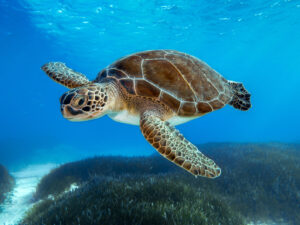 Take A Journey into Nature’s Wonders
Take A Journey into Nature’s Wonders
Green Turtles
Most of the turtles you will see on the Mangrove Island Turtle Tour are green turtles. The adults usually inhabit shallow lagoons and waterways, mainly feeding on various species of seagrasses. The turtles bite off the tips of the seagrass blades, which keeps the grass healthy.
Sea turtles are the living representatives of a group of reptiles that have existed on Earth and traveled our seas for the last 100 million years. Green sea turtles migrate long distances between feeding grounds and hatching beaches. Females crawl out on beaches, dig nests, and lay eggs at night. Later, hatchlings emerge and scramble into the water. Those that reach maturity may live to 90 years in the wild! Anatomically, a few characteristics distinguish the green turtle from the other members of its family. Unlike its close relative, the hawksbill turtle (the other type of turtle often seen during the Mangrove Island Turtle Tour), the green turtle’s snout is very short and its beak is unhooked.
The diet of green turtles changes with age. Juveniles are carnivorous, but as they mature, they become omnivorous. Young sea turtles eat fish and their eggs, jellyfish, small invertebrates, sponges, algae, sea grasses, leaves, and even tree bark. You might see them nibbling on the Turtle Grass that is abundant in the Mangrove Island channels you will be paddling through.
Green sea turtles migrate long distances between feeding and nesting sites; some swim more than 2,600km (1,600 mi) to reach their spawning grounds. Mature turtles often return to the exact beach from which they hatched. Females usually mate every two to four years. Males, on the other hand, visit the breeding areas every year, attempting to mate.
Sea turtles return to the beaches on which they were born to lay their eggs (called natal homing). The reason for returning to native beaches may be that it guarantees the turtles an environment with the necessary components for their nesting to be successful. These include a sandy beach, easy access for the hatchlings to get to the ocean, proper incubation temperatures, and low probability of predators that may feed on their eggs.
At around 50 to 70 days, the eggs hatch at night, and the hatchlings instinctively head directly into the water. This is the most dangerous time in a turtle’s life.
Sea turtles spend almost all their lives submerged but must breathe air for the oxygen needed to meet the demands of vigorous activity. With a single explosive exhalation and rapid inhalation, sea turtles can quickly replace the air in their lungs. During routine activity, green and loggerhead turtles dive for about four to five minutes and surface to breathe for one to three seconds.
Turtles can rest or sleep underwater for several hours at a time, but submergence time is much shorter while diving for food or to escape predators. During the night, while sleeping and protecting themselves from potential predators, the adults wedge under rocks below the surface and under ledges in reefs and coastal rocks. Many green sea turtles have been observed returning to the same sleeping location night after night.
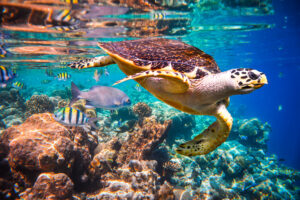 Hawksbill Turtles
Hawksbill Turtles
The second most common turtle you are likely to encounter during the Mangrove Island Turtle Tour is the hawksbill turtle. How can you tell them apart? Green turtles often have a clean shell with fan-shaped patterns on the scales, while hawksbill turtles have interlocking scales like roof tiles speckled with black spots and often have algae on top of their shell.
Hawksbill turtles grow to be smaller than green turtles. Green turtles can reach 1.2m and 120kg, while hawksbill turtles reach 0.9m and 90kg. However, nearly all of the green and hawksbill turtles you will see during the Turtle Tour through the mangrove islands are juveniles between 1-2 ft long (.5m and less).
Hawksbills feed mainly on sponges by using their narrow pointed beaks to extract them from crevices on the reef but also eat sea anemones and jellyfish.
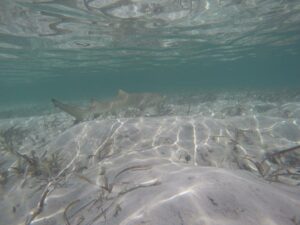 Juvenile Lemon Sharks
Juvenile Lemon Sharks
Around the Mangrove Island channels entrance is a large shallow area of sandy bottom that is only 1-2ft deep. This area is a very common place for juvenile lemon sharks to congregate. Most are about 1.5- 3 ft long (.5 – 1m) and challenging to see as they blend in very well with the sand.
Lemon sharks are, unsurprisingly, named after lemons. They have a yellowish tint to their skin, darker on their dorsal (back) side and lighter on their belly. This helps them blend into the sandy habitats where they search for food.
The lemon shark is one of over 1,000 species of shark. They are generally not considered to be dangerous to humans. This gentle nature makes them one of the most popular among shark divers and others who enjoy shark encounters.
Lemon sharks are very social with each other and follow strict social rules and hierarchy. Their eyesight is poor; thus, they rely on electroreceptors called ampullae of Lorenzini.
On average, lemon sharks live up to 30 years. The largest lemon shark recorded was around 12.1 feet (3.7 m) long and weighed over 550 lbs (250kg). It is a skilled nocturnal predator, often preying on crustaceans, stingrays, and bony fish. Lemon sharks do not have known natural predators.
Upside-down Jellyfish (Cassiopea)
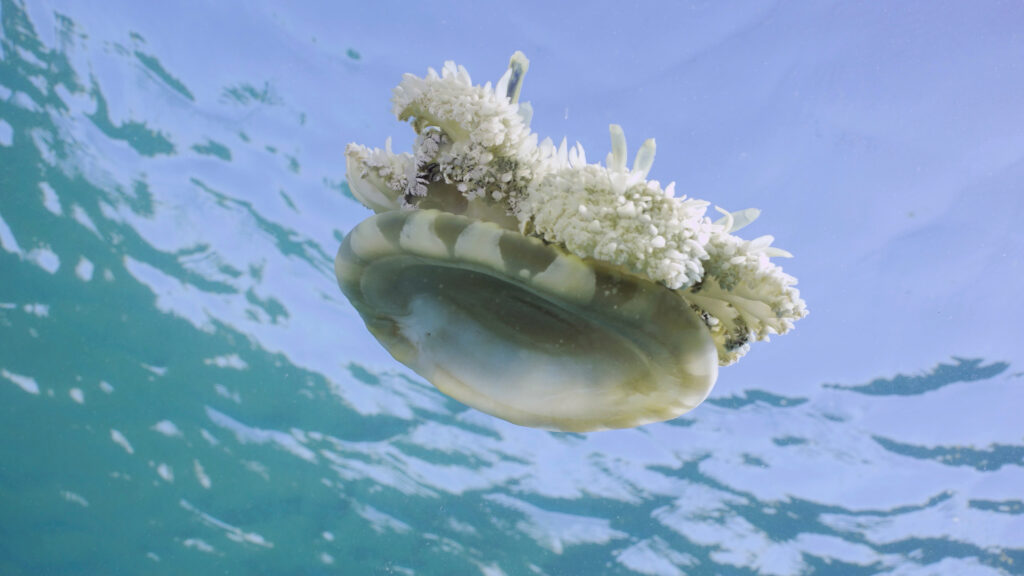
If you look closely at the bottom of the mangrove channel, you might see jellyfish that appear to be lying on the bottom. If you look even closer, you will notice they seem to be jellyfish that are flipped upside down, hence their name. These upside-down jellyfish are very common in the shallow mangrove channels throughout the Turks and Caicos Islands, especially where turtle grass (found everywhere in the mangrove channels). They are relatively harmless and will only ‘sting’ very sensitive skin, like lips. If you were to touch them with your hands or feet, you would likely not notice any stinging sensation.
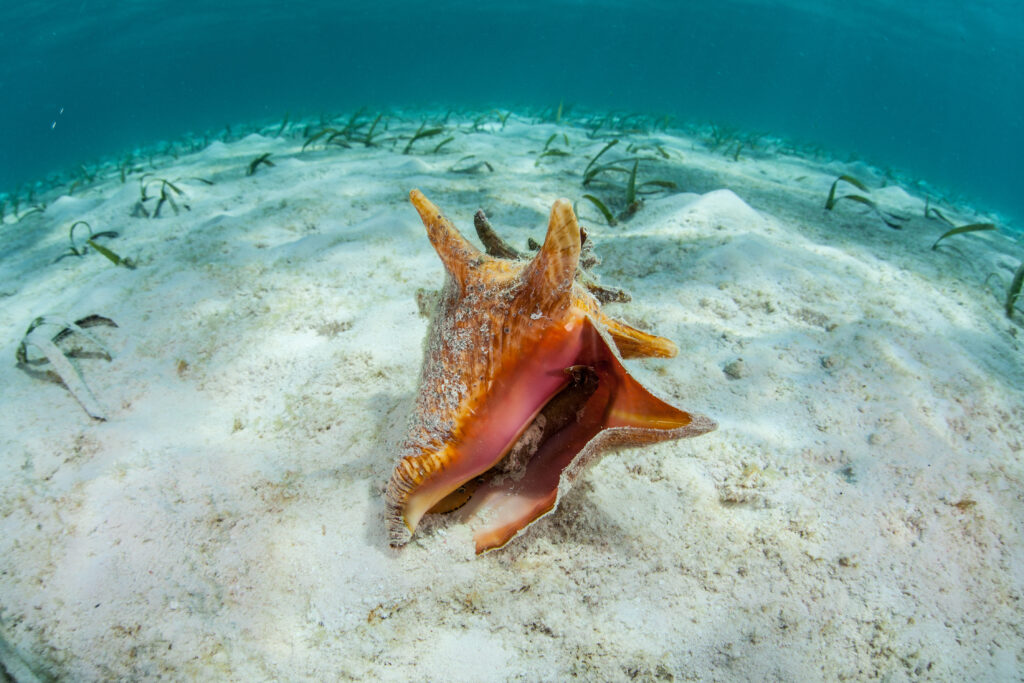
Queen Conch
If you keep your eyes fixed on the bottom of the sea bed during the Mangrove Island Turtle Tour, you will likely spot a queen conch. These are the same species of conch that you see on menus at restaurants here in the Turks and Caicos Islands. While they are a popular meal and once one of the most vital export marine species for our country, we are generally not supportive of harvesting them as their populations are now only a fraction of what they used to be ten years ago due to them being overfished. Luckily, many areas are protected from ‘conch diving’, such as the mangrove island channels!
Queen conch are slow-growing and late to mature, reaching up to 12 inches in length and living up to 30 years. The conch builds its shell out of calcium carbonate that it gets from the ocean. The shell grows with the snail-like creature you can see tucked into the shell. They reach sexual maturity after three years when their shells are about 8 in (20 cm) long. Most conch that you will encounter in the mangroves are between 6–12 in (15–30.5 cm) and weigh around 2-4lbs. The queen conch’s diet comprises seagrasses, algae, and organic debris.
The queen conch is best known for its bright pink, orange, or yellow coloring on the inside of the flared lip of its shell. You will likely come across their beautiful shells for sale at various places around the island.
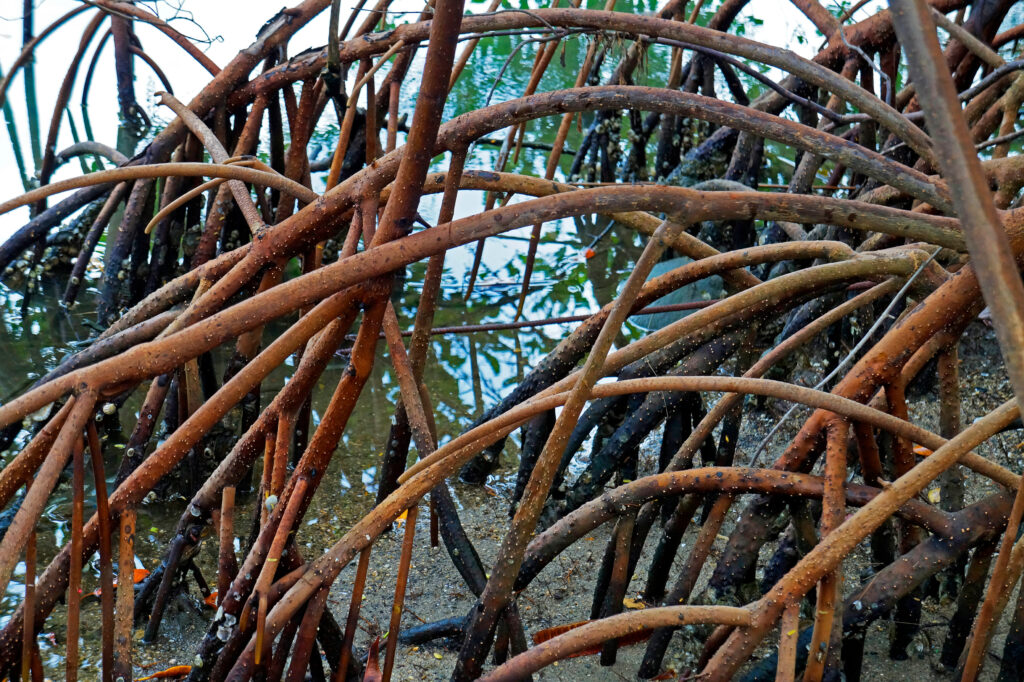 Red Mangrove
Red Mangrove
Mangroves are one of the most essential parts of the Turks and Caicos marine ecosystem. They are easy to spot due to their vast root systems above the ground and waterline. Red mangroves provide shelter for countless juvenile fish and birds and exceptional protection from erosion, especially during storms. The most common mangrove you will encounter during the Mangrove Island Turtle Tour is the red mangrove, which gets its name from the bright red color of the wood underneath the bark of the tree. Red mangrove trees can grow up to 80 feet. In order to grow that big in a soft muddy environment, the red mangrove has adapted aerial ‘prop roots’ which help prop up the tree and give it a spider-like appearance. These aboveground prop roots transport air to their waterlogged belowground roots.
You might notice the red mangroves’ “seeds” floating around. They are 6-inches long and have narrow tube-like sticks. These “seeds” become fully mature plants before dropping off the parent tree. These are dispersed by water until eventually embedding in the shallows where they grow into large mangroves.
Mangroves store more carbon than terrestrial forests and help fight coral bleaching. Mangroves help people weather the impacts of climate change — but they also help mitigate its causes. Globally, protecting mangrove forests can account for as much as 30 percent of the solution to climate change thanks to their ability to absorb and store carbon dioxide. Mangroves have the capacity to take far more carbon out of the atmosphere than terrestrial forests; a patch of mangroves could absorb as much as 10 times the carbon of a similarly sized patch of terrestrial forest!
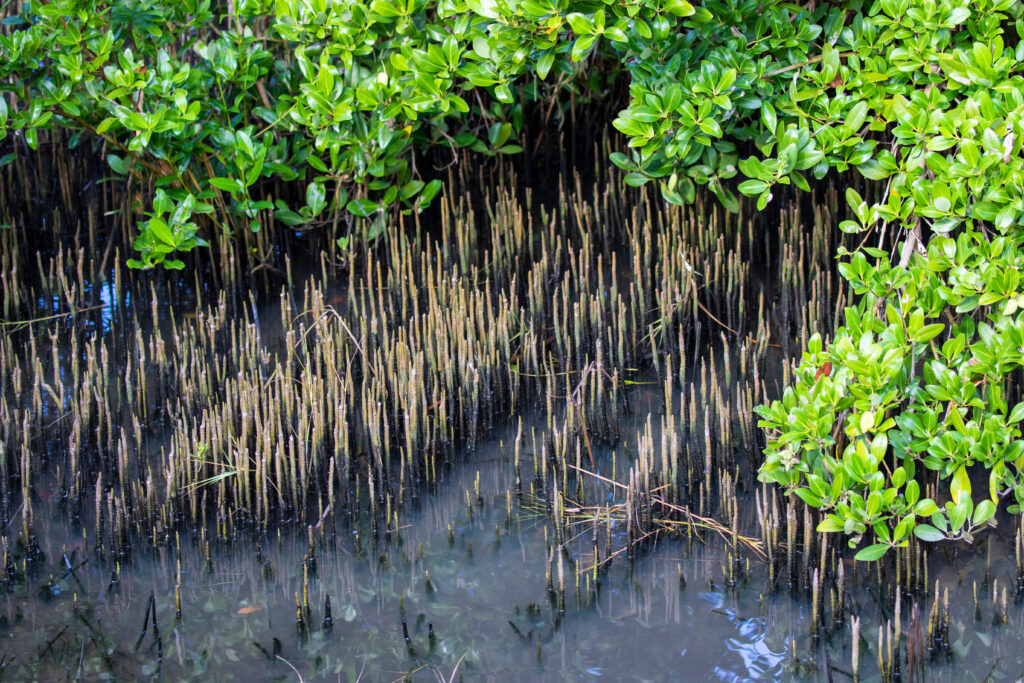
Black mangrove
Black mangroves are also very commonly seen during the Mangrove Island Turtle Tour. They are more like a small tree or shrub when compared to the red mangrove. They can grow up to 12 meters (39 feet). Unlike red mangroves, they do not grow on prop roots. The lack of these prop roots is the easiest way to tell them apart from red mangroves.
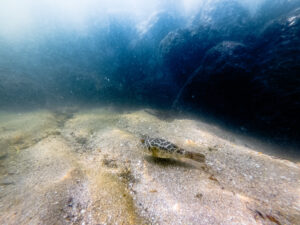 Checkered Pufferfish
Checkered Pufferfish
The mangrove roots are home to an abundant amount of checkered pufferfish. The pufferfish seen during the Mangrove Island Turtle Tour are about 4-6 inches long and have bright red eyes.
The checkered puffer is one of several fish species belonging to the family Tetradontidae, meaning “four teeth.” Puffers have four tooth plates arranged in quadrants, with two teeth on the bottom and two on the top. These teeth form a robust and heavy beak capable of cracking through hard prey such as mollusks and crustaceans. Puffers are named for their ability to swell by swallowing water or air when threatened.
Spend the Day Paddling in Paradise
Our guides love Mangrove Island and do their best to preserve it so visitors of Turks and Caicos can keep on enjoying it for years to come. This is why they will advise you not to touch the wildlife, to avoid stepping on the ground in order not to disturb this very interconnected ecosystem, and they’ll help you master your craft so you don’t crash into the mangrove and break its branches.
See What Our Boarders are Saying About Us!
Trustindex verifies that the original source of the review is Google. We had Jay as the instructor for my 15 year old daughter and myself and we had a great time and learned a lot. We had never done kite boarding before today and we learned enough basic controls of the kite, how to get it out of the water when we crashed it into the water and started to get up on the board. Jay was very patient even when I did not do what he said, my daughter listened so she was his favorite. If we have time we will probably do another lesson. I would highly recommend using the Kite Provo Kiteboarding school. Update: We went back to Turks and Caicos this summer and had Alan as our instructor and he was great, just refreshed us on the skills we learned last year and moved us forward. We had a great time and I do not know how to say this any better but Kite Provo Kiteboarding School is GREAT.Trustindex verifies that the original source of the review is Google. Great experience- SUPs were delivered on time and we used them for our entire trip.Trustindex verifies that the original source of the review is Google. Lovely morning with lots of wildlife, and a fantastic naturalist as guide and teacher! My daughters and I are fairly new to SUP, having only been once before, several years ago, with the same organization. The other participants cancelled at the last minute, and we had a private tour with Mark. He was absolutely the best we could possibly expect. Patient and calm, constantly keeping an eye on us to see that we felt safe, encouraging us to try and stand up where the water and wind were calm, etc. He is also very knowledgeable and caring about the marine ecosystem and sea-life. We saw lots of turtles, baby sharks, and various other creatures. We especially appreciated that he was focused on preserving the ecosystem, even at the expense of providing us with additional "thrills". He is also very honest about what he does and doesn't know. Thanks, Mark, for an exceptional experience.Trustindex verifies that the original source of the review is Google. Service was excellent. Instructor was patient and very friendly. I definitely recommendTrustindex verifies that the original source of the review is Google. Went for a water start refresher.... Lessons as expected. The team was super cool and friendly.Trustindex verifies that the original source of the review is Google. I had an absolute blast today trying out kitesurfing for the first time! The instructor was super patient with my errors and taylored the training perfectly to fit my life experience. Thanks to a phone call the morning of, I was able to get in the same day. The online reservation is for more than 24 hours notice.Trustindex verifies that the original source of the review is Google. Instructors are great, they showed me some issues with my technique and was improved by end of session. There will provide you with excellent equipment, but I brought my own and the instructor showed me some things about my equipment I didn’t even know .Trustindex verifies that the original source of the review is Google. Just finished a 10 lesson course (20 hrs) with Sarah Jane. Extremely satisfied, SJ has been very patient and helpful, and thanks to this I have been able to improvement considerably in all areas. Thanks also to Julie for the first lesson, also an excellent coach. And finally thanks also to Alan and the other coaches, they are a superb team for anyone who wants to improve and progress, Long Bay in Turks & Caicos is certainly one of the best places to learn and improve kitesurfing.





